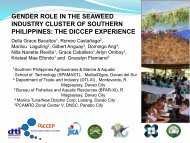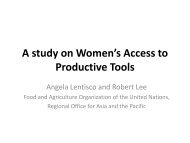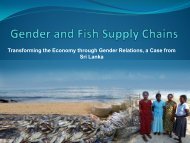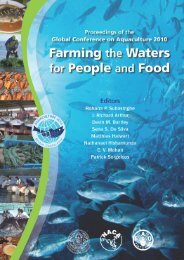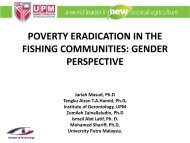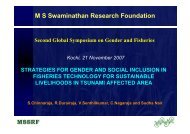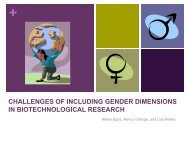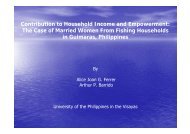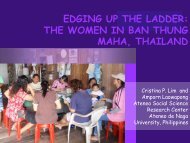Gay Defiesta's
Gay Defiesta's
Gay Defiesta's
Create successful ePaper yourself
Turn your PDF publications into a flip-book with our unique Google optimized e-Paper software.
<strong>Gay</strong> Defiesta, PhD<br />
University of the Philippines Visayas<br />
Miag-ao, Iloilo, Philippines
Introduction, Objectives, Methodology<br />
Background of the study and the oil spill<br />
Analysis of women’s economic<br />
marginalization before and after the oil<br />
spill<br />
Conclusions and recommendations
Disasters have different effects on men and<br />
women.<br />
Women and girls are among the most<br />
vulnerable sectors during disasters.<br />
Without disasters women already<br />
experience economic marginalization.<br />
Because of gender bias in the analysis of<br />
impacts and economic interventions during<br />
disasters, the economic marginalization of<br />
women is exacerbated.
1. Analyze the economic impacts of the oil<br />
spill on women in the severely affected<br />
coastal communities in Guimaras Island,<br />
Philippines.<br />
2. Find out if women are economically<br />
marginalized in these communities<br />
3. Determine if economic marginalization<br />
was exacerbated after the disaster.
Multi stage sampling technique<br />
- 112 study participants from the severely<br />
affected communities of the 2006 oil spill<br />
in Guimaras Island, Philippines.<br />
Triangulation: Interview survey, key<br />
informant interviews, focused group<br />
discussions
This paper is part of a bigger research<br />
conducted from 2007-2008 on the<br />
analysis of women’s experiences of<br />
gender bias following the MT Solar I Oil<br />
Spill in Guimaras Island, Philippines<br />
It focuses on economic marginalization of<br />
coastal women during disaster events.
Source: www.gov.guimaras.ph<br />
Figure 1: Location and Administrative Maps of Guimaras Island, Philippines
In August 2006, the tanker M/T Solar I<br />
sank in Guimaras Island in central<br />
Philippines and spilled about 2.6 million<br />
liters of bunker fuel.<br />
The oil spill affected three municipalities<br />
and about 20,000 individuals living along<br />
the coasts.<br />
Small scale fishing was the most affected<br />
sector.
Municipality<br />
Population<br />
Number of<br />
Households<br />
Number of<br />
Households<br />
Affected<br />
Nueva Valencia 35,475 7,757 2,185<br />
Sibunag 19,132 3,679 1,088<br />
San Lorenzo 23,293 4,395 371<br />
TOTAL 77,900 15,831 3,644
Women’s Roles in Fishing:<br />
Assisting husband in preparing/fixing<br />
the fishing gear.<br />
Gleaning and shell gathering along the<br />
shores with girls and elderly women.<br />
Fry gathering (done in shallow, usually<br />
waist-deep waters)
Fishing in mangrove areas<br />
Assisting husband in maintaining<br />
fish traps.<br />
Going offshore fishing with their<br />
husbands in the absence of an ablebodied<br />
son or close young male<br />
relative.<br />
Marketing fresh, dried or salted fish<br />
Fish drying/salting
Fishing resources in the area are<br />
male dominated:<br />
- Offshore fishing grounds are the<br />
domains of men<br />
- Females are limited along<br />
shallow waters, shores and<br />
mangrove areas.
Economic marginalization is evident<br />
even prior to the oil spill:<br />
- offshore fishing grounds are exclusive<br />
to men<br />
- shallow waters, shores and mangrove<br />
areas are left to women since fishing<br />
along these areas is considered<br />
“lighter, easier and less productive”<br />
- control of these “marginal fishing<br />
grounds” are not even exclusive to<br />
women alone as men also fish in these<br />
areas
- roles of women in the entire fishing<br />
activity are only supportive to that of<br />
men.<br />
- even the fishing households’ most<br />
common alternative source of<br />
income (agricultural and agricultural<br />
labor) is also male dominated.
Fishing and related livelihoods were<br />
disrupted by the oil spill.<br />
Women bore most of the brunt since the<br />
disaster was worst along the shorelines<br />
and mangrove areas (tidal action<br />
brought the oil and left the sludge along<br />
the shores)<br />
Gleaning and shallow water fishing<br />
completely stopped for several months.
The immediate concern was the provision of<br />
temporary income to affected families and<br />
individuals<br />
The assistance program to the oil-spill<br />
affected fishers included:<br />
1. Relief operations – distribution of food stuff<br />
2. Temporary work – cash-for-work program,<br />
minor construction, community clean-ups<br />
3. Livelihood – vegetable gardening, food<br />
processing.
Projects<br />
Number<br />
Clean & Green 10<br />
Vegetable Prod 38<br />
Construction 15<br />
Animal Dispersal (chicken) 1<br />
Food Processing 1<br />
Total 65
Project<br />
No. of<br />
Projects<br />
Male % Female % Total<br />
Clean & Green Program 7 79 75 26 25 105<br />
Vegetable Prod 24 218 57 166 43 384<br />
Construction 7 105 91 11 9 116<br />
Animal Dispersal 1 2 11 16 89 18<br />
Food Processing 1 7 32 15 68 22<br />
Total 40 411 64 234 36 645
• Three out of five projects had higher percentage<br />
of male beneficiaries.<br />
• These are also the major projects in number and<br />
expenditure.<br />
• Clean-up activities in the community and<br />
gardening are often associated with females but<br />
most of the beneficiaries of these projects were<br />
male.<br />
• Minor construction work was clearly male<br />
dominated.<br />
• Food processing and animal dispersal<br />
beneficiaries were mostly females
Source of picture: www.greenpeace.org<br />
Source of picture: www.chrispforr.net
Generally,<br />
Men benefitted more from the projects both in terms of<br />
number and aggregate amount.<br />
Economic marginalization of women was exacerbated<br />
by the oil spill<br />
- women’s livelihoods were affected more than any other<br />
sector<br />
- they received less of the benefits<br />
- their needs were considered less important leading to<br />
minimal institutional interventions
The results of the study affirm that disasters affect<br />
men and women differently.<br />
It also highlights the importance of using gender<br />
perspective in analyzing economic impacts of<br />
disasters.<br />
Economic interventions for disaster victims (relief<br />
operations, income provision and food security) must<br />
consider the spheres of economic activity of men and<br />
women for equitable distribution of benefits<br />
Disaster preparedness and response programs from<br />
mitigation (e.g. early warning systems) to<br />
rehabilitation (e.g. relief operation) should be<br />
gender-sensitive and gender-fair.
Thank you!



